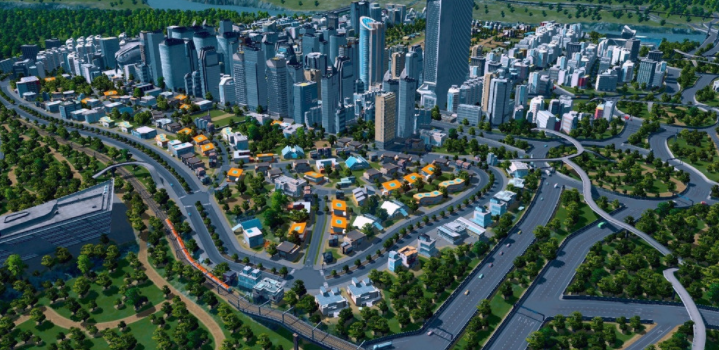Skylines of Cities The primary goal of the development is to accommodate three distinct uses: residential, commercial, and industrial. How is it decided how much of each of these three categories is met? The Cities: Skylines demand study and suggested layouts below fall into three distinct categories. Look, I'll show you.

To begin, the need for dwellings. If the green bar goes up, it's clear that additional housing has to be planned; if it goes down, however, people will start constructing homes in the housing they've already approved.
Additionally, there are practical considerations for companies to take into account. If the blue bar rises, it's clear that more commercial zones need to be planned. At the same time, though, people will keep constructing stores and restaurants in the commercial zones you design until the bar is completely depleted.
Last but not least, it is the main point of this piece. Planning for industrial and office areas does lead to the construction of factories and office buildings until the rising yellow bar of "industrial demand" reaches zero. But does the yellow bar of industrial demand rise indicate you need to design more industries or offices, according to the logic of residential and commercial demand and the suggestions in the game?
Actually, no.
Several iterations of testing have led me to the conclusion that an increase in the yellow demand bar indicates an increased need for employment opportunities among your population. As such, you should prioritize the construction of new industrial, office, commercial, and even municipal structures to meet this demand. Some examples are the police station and the hospital!
The data on employment and unemployment may be found under the "Population" tab. Total population appears on the first line, active workers on the second, and several translations of "job openings" appear on the third, which together signify "job openings!" Alternatively "jobs available!"
The rate of unemployment is shown by the fourth line. The final three of these groups—those aged 15 to 24 years old, those aged 25 to 54 years old, and those 55 years old and over—make up the base (denominator) for the unemployment rate. However, the realities faced by children and teenagers are not captured by these statistics.
Having a high unemployment rate immediately causes the yellow demand bar to climb.
The question is, how do these three necessities relate to one another? Who or what drives the uptick in demand, if anything at all?
First, the quantity of employment you can create has an impact on the demand for housing. When there are more open jobs than people to fill them, housing demand rises. Of course, it's a different story when your death rate is abnormally high… (A non-native speaker of English produced an essay on the mass fatality, and I will summarize it for you in the next paragraph.)
It's the number of people that live in an area that ultimately determines the level of business demand (blue bar growth). Insufficient commodities indicates that your business district is too congested, traffic is unpleasant, and the supply of products is unreliable; client shortage indicates that there are a little more commercial planning temporarily. It's important that an enterprise be not too distant from the freight terminal, particularly if it imports goods.
The unemployment rate is the primary determinant of job demand/"industrial demand." The yellow bar rises to represent an increasing unemployment rate. Jobs may be created by constructing nearly anything other than a house.
After the reasoning is understood, what problems remain?
To begin, we can break the first indicated infinite loop. This means you may begin the game as usual (unlocked, with a small starting budget), allowing you to focus on developing your city's residential and commercial sections while relying on the forest and animal husbandry to supplement your economy until you can build up your city's infrastructure (of course, it also poses a great challenge to transportation). The requirement for yellow stripes is not anything to be concerned about.
If that's the case, there's no reason to resort to the demand master's modification!
On the other hand, the awkward question of how many people live in a skyscraper or how many people work in a skyscraper, which moves the gameplay further away from emulating the real world, can be easily resolved by installing and using the real population mod, which can be used depending on the needs.
It has also been recommended that fewer schools be constructed in order to provide room for the expansion of non-academic uses of land, such as forestry, animal husbandry, and industry, and for the relocation of administrative functions away from the campus. In elementary and secondary schools in particular, the green bar on the red, yellow, and green status bar of education cannot be crossed. When given enough time, even the most disruptive students will eventually show up for class. Then, there is a dearth of workers in the agriculture and forestry industries.
The communal dying event, first known as "viewing your city," is the subject of my last discussion. Here, I will quickly translate it for you.
That is, a large number of individuals in the city will all of a sudden pass away, necessitating a large number of hearses for the local administration, while simultaneously leaving the factory short on workers.
In this game, inhabitants go through five distinct eras, from childhood to old age. Each individual goes through a similar life cycle. Planning a city in such a way that a huge number of people live in the same neighborhood all at once guarantees that many of those people will perish in the same disaster. They won't just end their lives together, but also their careers and their lives in retirement. There will be a severe scarcity of workers after they all perish at once… Thus, some degree of urban residential area planning is preferable. In addition, it's a more accurate depiction of reality.
When it comes down to it, we insist that you upgrade to the latest version of Move it! The implementation of this mod couldn't be simpler. Why doesn't the game just make it an official thing? Because of the crossing of the arc-making line, this upgrade is essential! While doing so, you can relocate standalone structures or green spaces.
This hack removes the possibility of contact with the road, any in-game objects, and trees. I have no idea if there is compatibility between these two upgrades. In a nutshell, there is increased leeway for constructing roads and setting up structures. To construct a city that isn't perfectly square, you need the aforementioned three modifications. In the future, you may want to think of beginning with a few cement brushes, wheat field elements, modifying the road color, applying filters, and eventually adding hundreds of assets, Rico, or whatever.
More importantly, we need to investigate this when subscribing to assets. It may be necessary to install additional modifications or props before using some assets. If these conditions aren't met, the game won't launch properly and its unfinished assets will be shown instead.
At a population of 900, the block function was successfully unlocked, allowing forest and livestock management to be planned.
The Zero Industrial Zone must have a power plant and a rubbish recycling facility constructed. Additionally, a primary school and medical clinic have been constructed, although a fire station and police station have not.
Urban regional planning was the subject of a post I once read, but since the article has now been lost, I will have to rely on my memory to elaborate.
Knowing how much people want to drive about your city is the first step in making plans. People in the skyline have three distinct transportation needs: getting to and from work, getting back home, and getting to and from retail establishments. The commercial district's modest delivery vehicles must leave to pick up items and then return with them. Large trucks are brought in from overseas, sent overseas, delivered to the business district, and brought back.
Consequently, the ideal regional model based on these requirements should satisfy the needs of lowering the number of inappropriate roads for all vehicles:
The typical day for a citizen consists of commuting to work in the manufacturing district, spending time at a retail location after work, and then returning home.
Pick up inventory from a factory or freight terminal and deliver it to a retail location using a commercial minivan.
Commercial and industrial zone: shipping items to retailers and then heading back to the plant
Manufacturing district: free trade zone.
Because of this, the first two regional models in the preceding picture are acceptable.
There is a third form in which homes are situated in proximity to places of commerce; this is the one most people unconsciously choose. The regional model of industry on the periphery of residential buildings is a waste of traffic resources, at least in the game, because it will cause residential areas to bear two additional traffic pressures at once: "commercial minivans: go to the factory or freight point to pick up goods – return to the store" and "industrial areas: deliver goods to the store – return to the factory." Simultaneously, commercial and industrial productivity declines.
The End
The commercial zone must be next to the industrial zone for the delivery of large trucks or small trucks, and the industrial zone must have a dedicated route for quick access to the city for the import and export of large trucks.
People should be able to easily get back home from the store if it is located close to their residence. (The business district can, of course, be dispersed within the residential district, but the overall area covered shouldn't be too large.)
Commuters from the surrounding neighborhoods may easily access the nearby manufacturing facilities.
Last but not least, work with your public transit to link the destination blocks of these residents, and you'll see a significant decrease in traffic congestion.
A fresh map should be updated. The industry is plagued by the city's 3,000 inhabitants. Forestry is on the left, while livestock farming is on the right. After the Forgive City DLC, the forestry and animal husbandry industries will be the only sources of the commodities needed by the "organic business district," marking the end of an age in which general industry supplied such commodities.

